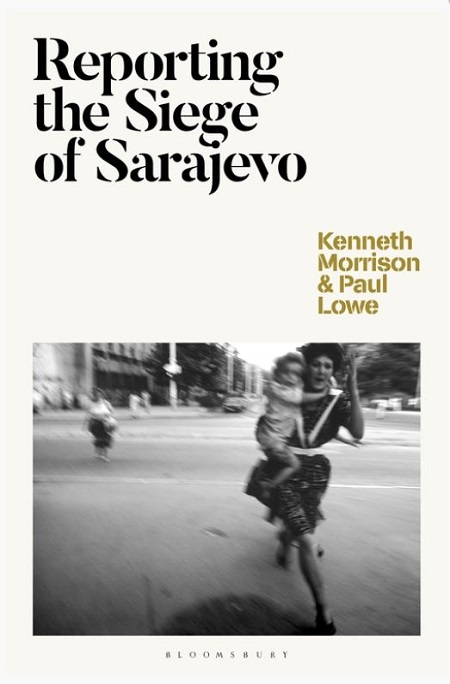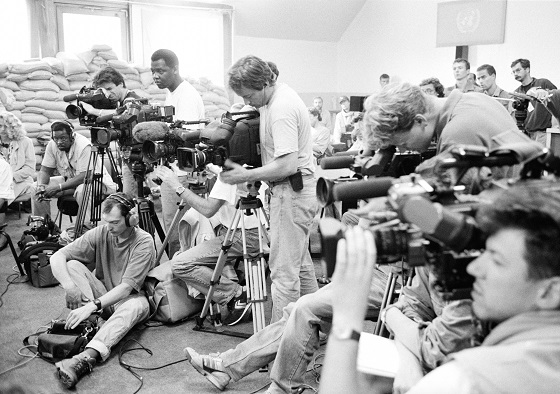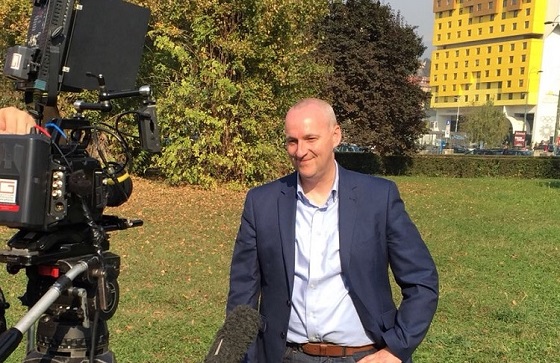A world-renowned expert in Balkan history from De Montfort University Leicester (DMU) has co-authored a new book on how journalists from around the globe covered the longest siege in modern warfare.
Kenneth Morrison, DMU's Professor of Modern Southeast European History, has published his latest book, 'Reporting the Siege of Sarajevo' with the photojournalist and academic Dr Paul Lowe.

The front cover of the new book
Published by Bloomsbury, the book gives a detailed account of how foreign correspondents, their crews and their local staff functioned within Sarajevo during the 1992-96 siege of the city.
When Bosnia and Herzegovina declared independence from Yugoslavia after an independence referendum in 1992, the Bosnian Serb Army encircled Sarajevo with a siege force of 13,000 stationed in the surrounding hills. From there they assaulted the city with artillery, tanks, and small arms.
Almost 12,000 people were killed during the siege, many of them civilians. The world's TV, radio and print journalists were based inside Sarajevo, in particular at the Holiday Inn, which remains familiar to many around the world who saw the nightly news reports filed at the height of the siege and the war in Bosnia.
During the research for the book, Professor Morrison and Dr Lowe interviewed close to one hundred foreign correspondents, editors, cameramen, photojournalists, satellite engineers, translators and fixers from media organizations such as the BBC, Reuters, Associated Press, CNN, the New York Times, Le Monde, Newsweek, the Guardian and many others.

Journalists at a UN briefing in Sarajevo ©Paul Lowe
The resulting book provides a fascinating insight into the role and function of the foreign journalists, the media infrastructure that developed in besieged Sarajevo and, at a key time in the history of journalism, how technological developments changed the way that correspondents worked. It has been described by Dr Lara Nettlefield of Columbia University in the US as a 'masterfully documented book'.
Professor Morrison said: "The idea for the book stemmed from my previous work on Sarajevo's frontline hotel, the Holiday Inn.
RELATED NEWS
Professor's expertise sees him appear in TV series 'War Hotels'
Prof Morrison's role as specialist advisor in the House of Lords
Academic's book about war hotel could become TV drama
"I knew from researching and writing a book about that building that there was a much bigger story to be told about the reporting infrastructure that developed during the siege.
"I mentioned the idea to Paul, who has, as a photojournalist, covered the siege, and we decided to work on the project together because we knew we could bring different skills to it. And it proved to be a very fruitful collaboration indeed."
Professor Morrison and Dr Lowe spent three years conducting the research for the book, which draws upon a range of archival material, contemporary newspaper reports in a wide range of publications - including the Bosnian daily Oslobodjenje which continued to be published, under the most difficult of circumstances, throughout the siege - and extensive interviews.
The book also features photographs taken by Paul Lowe during the siege, many of which have never been published before.

Legendary BBC war correspondent Kate Adie in Sarajevo ©Paul Lowe
Professor Morrison continued: "The story of how the siege was reported is a remarkable one.
"Covering the siege required significant endeavour, in terms of creating an infrastructure that would allow journalists to send their stories out of the city.
"At the start of the siege, digital technology was is in its infancy and journalists still used rather traditional means of communicating with their editors. With most of the phone lines in the city severed, the satellite phone - at that time a heavy and expensive piece of equipment - became vital.
"So too was the feed-point established by the European Broadcasting Union (EBU) based in the Sarajevo TV station which became a vital part of that infrastructure. This this is where, in the main, journalists fed their stories and images through the satellite uplink there."
In addition to writing the book, Professor Morrison has also gathered exhibits that will form part of a redesigned 'Besieged Sarajevo' exhibition based in the History Museum of Bosnia & Herzegovina.

Prof Morrison films a documentary outside Sarajevo's Holiday Inn
He said: "There will be a dedicated section in the exhibition that focuses on foreign correspondents in the city during the siege.
"Many of those who we had interviewed for the book were keen to donate and we subsequently garnered an incredible amount of unique and valuable items - old satellite phones, laptops, tape recorders, television cameras, flak jackets, helmets, notebooks, even locally-produced 'siege cigarettes' - all of which were important tools of the trade for any journalist working in the besieged city."
Professor Morrison's intimate knowledge of the complex modern history of the Western Balkans saw him called to a House of Lords inquiry to work as a Specialist Adviser for the International Relations Select Committee, as well as act as a consultant for the Foreign Office, Ministry of Defence and the Organisation for Security and Cooperation in Europe (OSCE). He has recently won a DMU award for Research-Engaged Teaching in recognition of his work on the popular third year 'Yugoslavia and Beyond' module.
One of Professor Morrison's previous books 'Sarajevo's Holiday Inn: On the Frontline of Politics and War' led to him becoming an advisor for, and appearing in, an Al-Jazeera documentary series called 'War Hotels'.
Posted on Thursday 21 January 2021